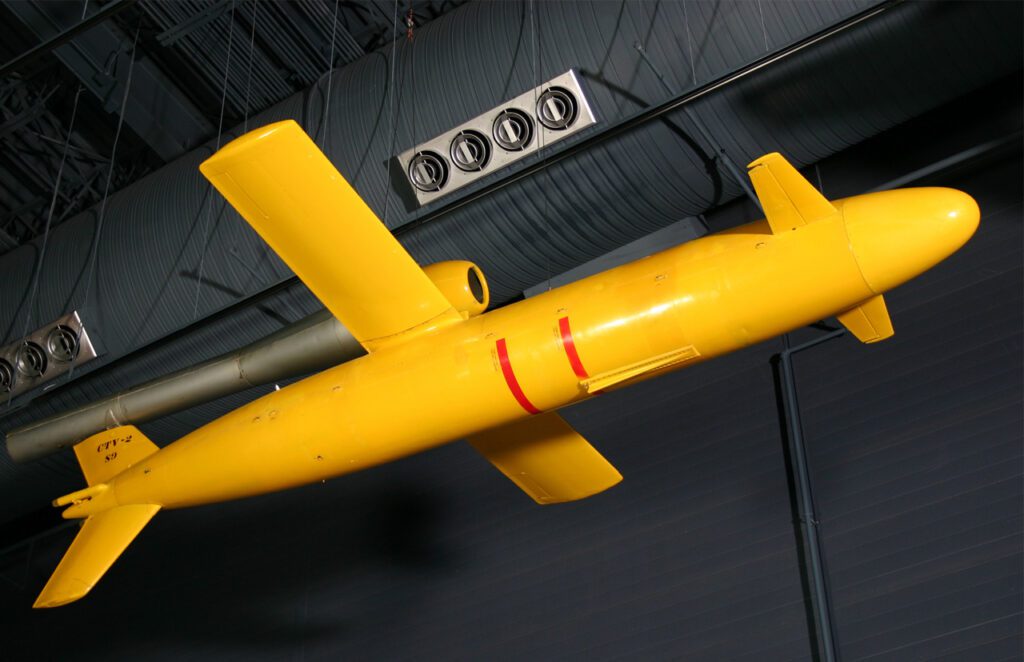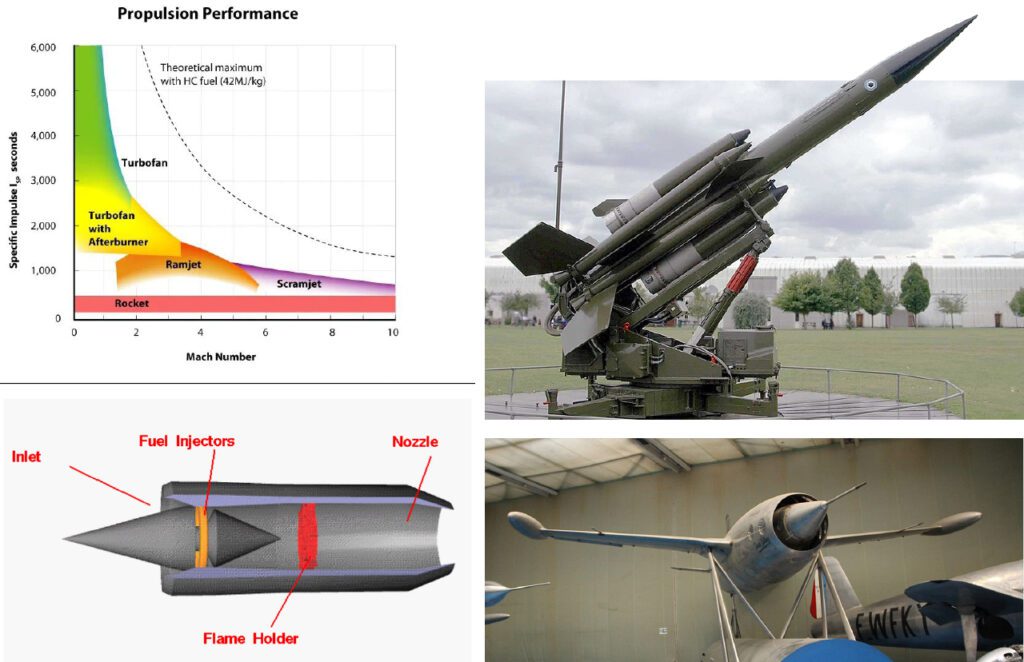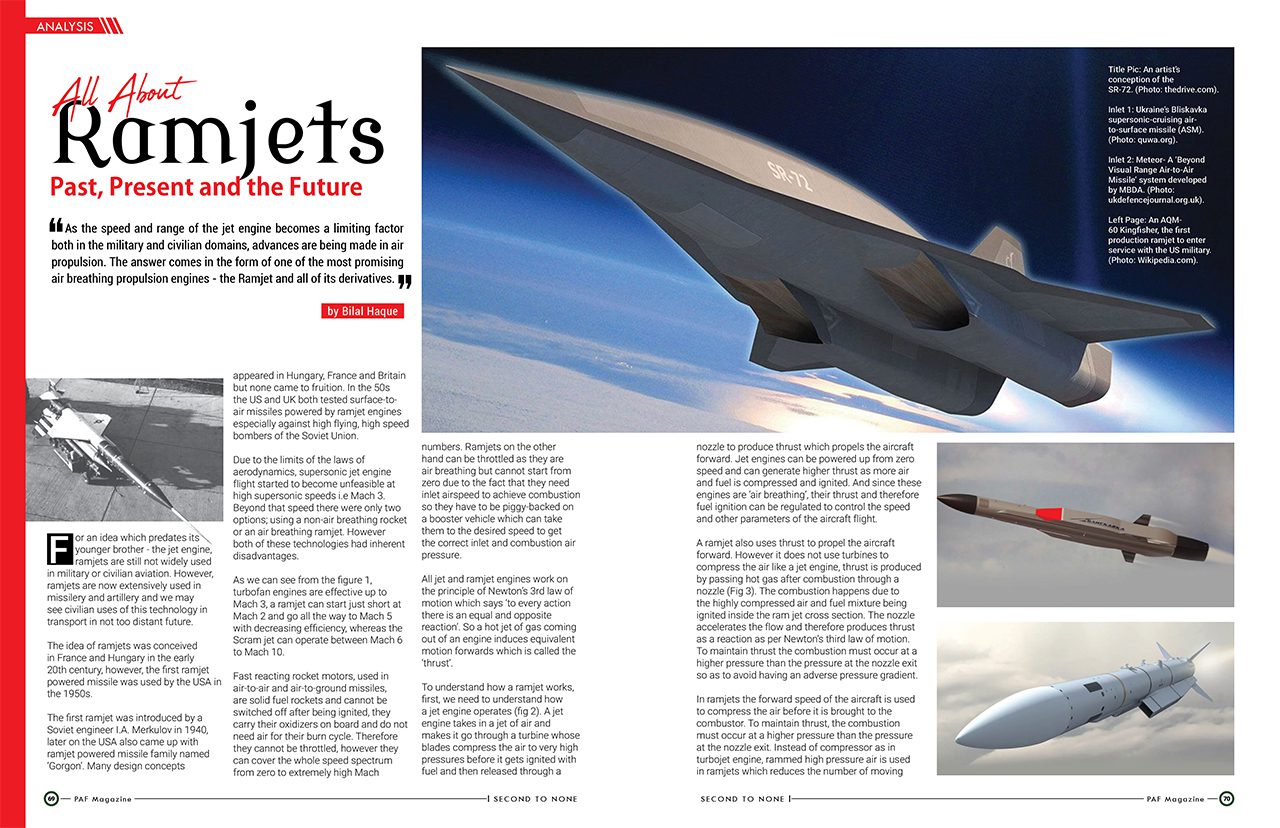As the speed and range of the jet engine becomes a limiting factor both in the military and civilian domains, advances are being made in air propulsion. The answer comes in the form of one of the most promising air breathing propulsion engines – the Ramjet and all of its derivatives.
For an idea which predates its younger brother – the jet engine, ramjets are still not widely used in military or civilian aviation. However, ramjets are now extensively used in missilery and artillery and we may see civilian uses of this technology in transport in not too distant future.
The idea of ramjets was conceived in France and Hungary in the early 20th century, however, the first ramjet powered missile was used by the USA in the 1950s.
The first ramjet was introduced by a Soviet engineer I.A. Merkulov in 1940, later on the USA also came up with ramjet powered missile family named ‘Gorgon’. Many design concepts appeared in Hungary, France and Britain but none came to fruition. In the 50s the US and UK both tested surface-to-air missiles powered by ramjet engines especially against high flying, high speed bombers of the Soviet Union.
Due to the limits of the laws of aerodynamics, supersonic jet engine flight started to become unfeasible at high supersonic speeds i.e Mach 3. Beyond that speed there were only two options; using a non-air breathing rocket or an air breathing ramjet. However both of these technologies had inherent disadvantages.

As we can see from the figure 1, turbofan engines are effective up to Mach 3, a ramjet can start just short at Mach 2 and go all the way to Mach 5 with decreasing efficiency, whereas the Scram jet can operate between Mach 6 to Mach 10.
Fast reacting rocket motors, used in air-to-air and air-to-ground missiles, are solid fuel rockets and cannot be switched off after being ignited, they carry their oxidizers on board and do not need air for their burn cycle. Therefore they cannot be throttled, however they can cover the whole speed spectrum from zero to extremely high Mach numbers. Ramjets on the other hand can be throttled as they are air breathing but cannot start from zero due to the fact that they need inlet airspeed to achieve combustion so they have to be piggy-backed on a booster vehicle which can take them to the desired speed to get the correct inlet and combustion air pressure.
All jet and ramjet engines work on the principle of Newton’s 3rd law of motion which says ‘to every action there is an equal and opposite reaction’. So a hot jet of gas coming out of an engine induces equivalent motion forwards which is called the ‘thrust’.
To understand how a ramjet works, first, we need to understand how a jet engine operates (fig 2). A jet engine takes in a jet of air and makes it go through a turbine whose blades compress the air to very high pressures before it gets ignited with fuel and then released through a nozzle to produce thrust which propels the aircraft forward. Jet engines can be powered up from zero speed and can generate higher thrust as more air and fuel is compressed and ignited. And since these engines are ‘air breathing’, their thrust and therefore fuel ignition can be regulated to control the speed and other parameters of the aircraft flight.
A ramjet also uses thrust to propel the aircraft forward. However it does not use turbines to compress the air like a jet engine, thrust is produced by passing hot gas after combustion through a nozzle (Fig 3). The combustion happens due to the highly compressed air and fuel mixture being ignited inside the ram jet cross section. The nozzle accelerates the flow and therefore produces thrust as a reaction as per Newton’s third law of motion.
To maintain thrust the combustion must occur at a higher pressure than the pressure at the nozzle exit so as to avoid having an adverse pressure gradient.
In ramjets the forward speed of the aircraft is used to compress the air before it is brought to the combustor. To maintain thrust, the combustion must occur at a higher pressure than the pressure at the nozzle exit. Instead of compressor as in turbojet engine, rammed high pressure air is used in ramjets which reduces the number of moving parts and makes them simpler in architecture. However, that means that the ramjet powered vehicle needs to be brought to flight and to a certain speed using some other kind of propulsion so as to give air enough pressure to be combusted in the combustion chamber.

However the combustion in the ramjet occurs at subsonic speed, for high supersonic speeds the air needs to be slowed down by the ramjet inlet to be usable, later. However, above Mach 5 the ramjets become inefficient due to the supersonic velocity of the air coming in. Answer to this problem is supersonic combustion ramjet, the Scramjet (Fig 4). The difference between a ramjet and a Scramjet, basically, lies in the speed of air at which combustion takes place. As previously discussed, a ramjet slows down supersonic inlet air speed to achieve combustion, whereas the Scramjet does not need to slow down the air and can achieve combustion with supersonic inlet speeds therefore proving extremely effective at high hypersonic speeds.
That’s why we can see ramjets having a launch propulsion system that engages before the ramjet takes over, so as to take the ramjet at a speed at which the inlet air speed is enough for its own combustion to take over. These ‘piggy back’ propulsion systems are normally jet engines or rocket engines.
In the world of missilery we have the example of ramjet powered missile and a dual pulse rocket motor powered missile as contrasting examples.
The dual pulse missile uses two solid fuel rocket motors which are fired at separate times to give the missile enough range, but since they are solid rocket fuelled and not ‘air breathing’ they cannot be throttled. Therefore it maintains the same rate of combustion during motor firing time, making them easier and cheaper to manufacture. However, during the burn phase it is hard to maneuver the missile due to the rockets forward momentum and after the burn time, its glide time with optimum energy is lower than that of a throttle-able ‘air breathing’ engine which uses the air as the oxidizer. This means that the ‘No Escape Zone’ for the dual pulse rocket motor engine would be smaller than that of an air breathing propulsion system such as a ramjet. Because in ramjets, the speed can be optimized till it gets to the terminal phase of its flight to have enough energy to engage a maneuverable target with a bigger ‘No Escape Zone’.
The ‘No Escape Zone’ being the area in which the missile cannot be beaten by the kinetic energy as it has enough energy to target a maneuvering aircraft.

We might see ramjet powered antiramjet missiles in the future, so its’ going to be very interesting to see how things move forward on the ramjet missile defense due to high supersonic speeds ramjets get to. The fastest commercial planes we have seen so far have been the Anglo French Concorde and the Russian Tu144. Both could sustain Mach 2 but were commercially unsuccessful. Therefore we still see commercial aircraft speeds at subsonic levels and long flights of up to 15 hours or more. With the existing levels of technology we can still not make supersonic commercial aircraft which will be economically viable. However things are changing rapidly in the military domain, it wasn’t long ago when Lockheed’s skunk works designed SR-71 was the king of the world in terms of top and sustained speed, believed to be in excess of Mach 3. To go faster, jet engines showed limitations and needed a rocket engine which also had its own inherent limitations.
That’s why, today we see the development of the successor of SR-71, the SR-72.
Researchers predict it will reach Mach 6 and if stationed in different parts of the world, will be able to reach any trouble spot for strike in an hour and will be able to circumnavigate the world in 6 hours flat! Try chasing that!
Rumor also has it that it will be powered by a hybrid turbofan/Scram jet engine with common inlets and nozzles. Apparently the same hybrid engine will be used to power the next generation of hypersonic missiles and hypersonic glide vehicles coming out of USA. However, it won’t be long before we can manufacture aircrafts which is not only fast but economically viable in commercial use as well.
It is perceived that such an aircraft would be equipped with the hybrid of jet and ramjet technology that would reduce travel times for circumnavigating the globe to a couple of hours.
As technology improves we can safely say that future of commercial and military air propulsion will be driven by ramjets and scramjets.








